The Ultimate Guide to Indian Massage in London
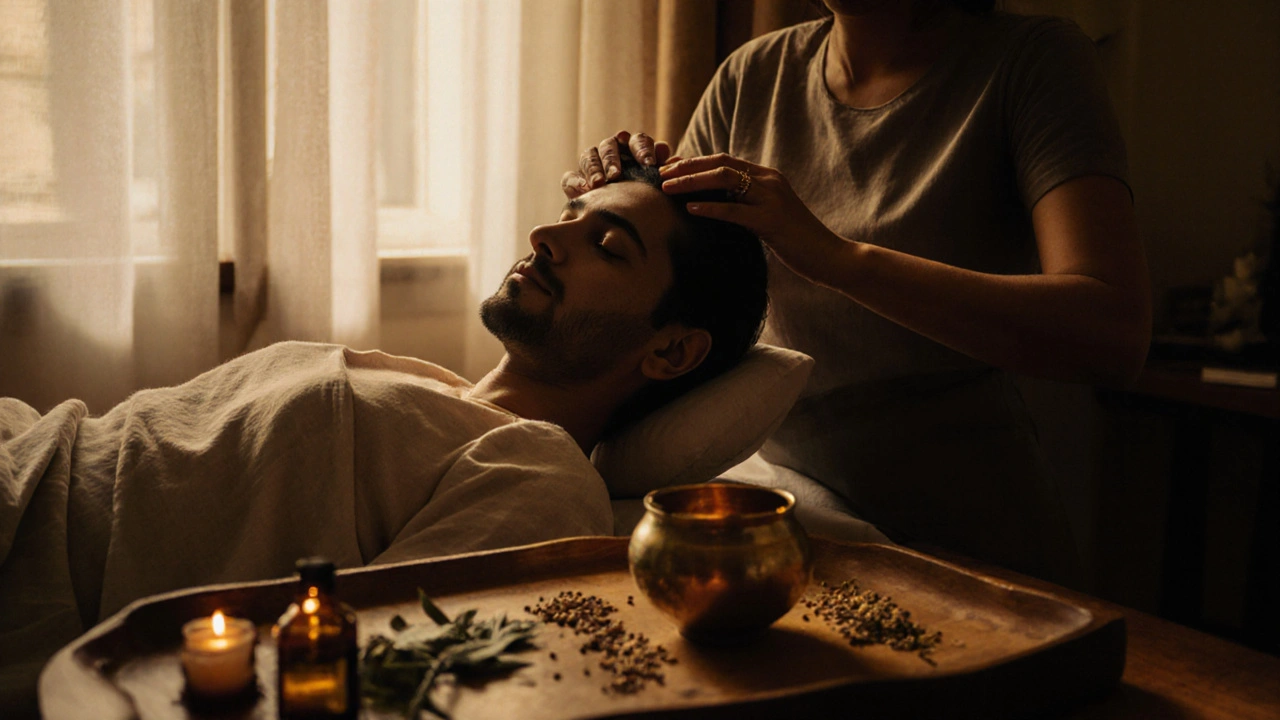
When you think of massage in London, you might picture Swedish strokes or deep tissue work. But tucked into quiet corners of Notting Hill, Brixton, and Camden, there’s something older, deeper, and more rooted in tradition: Indian massage. Not the kind you find in a spa brochure with lavender oil and ambient music. This is the real deal - passed down for thousands of years, used in villages across Punjab and Kerala, and now quietly thriving in London’s backstreets.
What Exactly Is Indian Massage?
Indian massage isn’t one thing. It’s a family of techniques that come from Ayurveda, the ancient Indian system of medicine. Unlike Western massages that focus on muscles, Indian massage works on energy channels called nadis and pressure points called marma points. These are believed to connect the body, mind, and spirit. The goal isn’t just to relax - it’s to rebalance.
The two most common types you’ll find in London are Indian head massage and full-body Ayurvedic massage. The head massage, often called champi, uses rhythmic pressure on the scalp, neck, and shoulders. It’s done seated, fully clothed, and usually with warm herbal oil. The full-body version involves long, flowing strokes, joint mobilization, and deep compression. It’s not gentle. It’s meant to release deep tension - the kind that builds up over years of stress, poor posture, or chronic fatigue.
Most places in London use sesame, coconut, or mustard oil infused with herbs like ashwagandha, turmeric, or brahmi. These aren’t just for scent. Studies from the Journal of Ayurveda and Integrative Medicine show these oils reduce inflammation and improve circulation when used in massage. You won’t find this in a typical London spa. This is medicine, not luxury.
Why Indian Massage Works Better Than You Think
If you’ve tried Swedish or deep tissue and still feel tired, you’re not broken. You just haven’t found the right kind of touch. Indian massage doesn’t just relax your muscles - it resets your nervous system. The pressure on marma points stimulates the vagus nerve, which lowers cortisol and triggers the body’s rest-and-digest mode. That’s why people report better sleep, fewer headaches, and less anxiety after just one session.
One Londoner, Priya, 42, who works in finance, started coming for weekly head massages after her doctor told her her chronic migraines were stress-related. Within three weeks, her headaches dropped from five times a week to once. She didn’t change her diet. She didn’t take pills. She just got her scalp worked on with warm almond oil and gentle circular motions for 45 minutes.
Another benefit? Digestion. The abdominal strokes in Ayurvedic massage stimulate the gut. People with IBS or bloating often see improvement after regular sessions. That’s not a side effect - it’s the point. In Ayurveda, the gut is called the second brain. Massage there isn’t optional. It’s essential.
Where to Find Authentic Indian Massage in London
Not every place that says “Indian massage” in London is genuine. Some shops use the name to attract tourists. Others mix it with Thai or Swedish techniques. Here’s how to tell the real ones:
- Look for therapists trained in Ayurveda or who studied in India - especially Kerala or Varanasi. Ask where they trained. If they say “online course” or “certified in 2 days,” walk away.
- Check the oil. Authentic places use cold-pressed, unrefined oils. If it smells like vanilla or coconut water, it’s probably synthetic.
- They won’t rush you. Sessions last 60 to 90 minutes. No 30-minute deals. If it’s cheaper than £50, it’s not real.
- They’ll ask about your dosha - Vata, Pitta, or Kapha. This is the Ayurvedic body type. If they don’t ask, they’re not practicing Indian massage. They’re doing a fancy rubdown.
Here are three places in London known for authenticity:
- Shanti Ayurveda (Notting Hill): Run by a therapist from Kerala. Uses only organic oils. Book ahead - they have a 6-week waitlist.
- Heritage Massage Co. (Brixton): Focuses on head massage. Popular with students and creatives. Open until 10 PM.
- Amrit Wellness (Camden): Offers full-body Ayurvedic massage with herbal steam before the session. The only place in London that does it right.
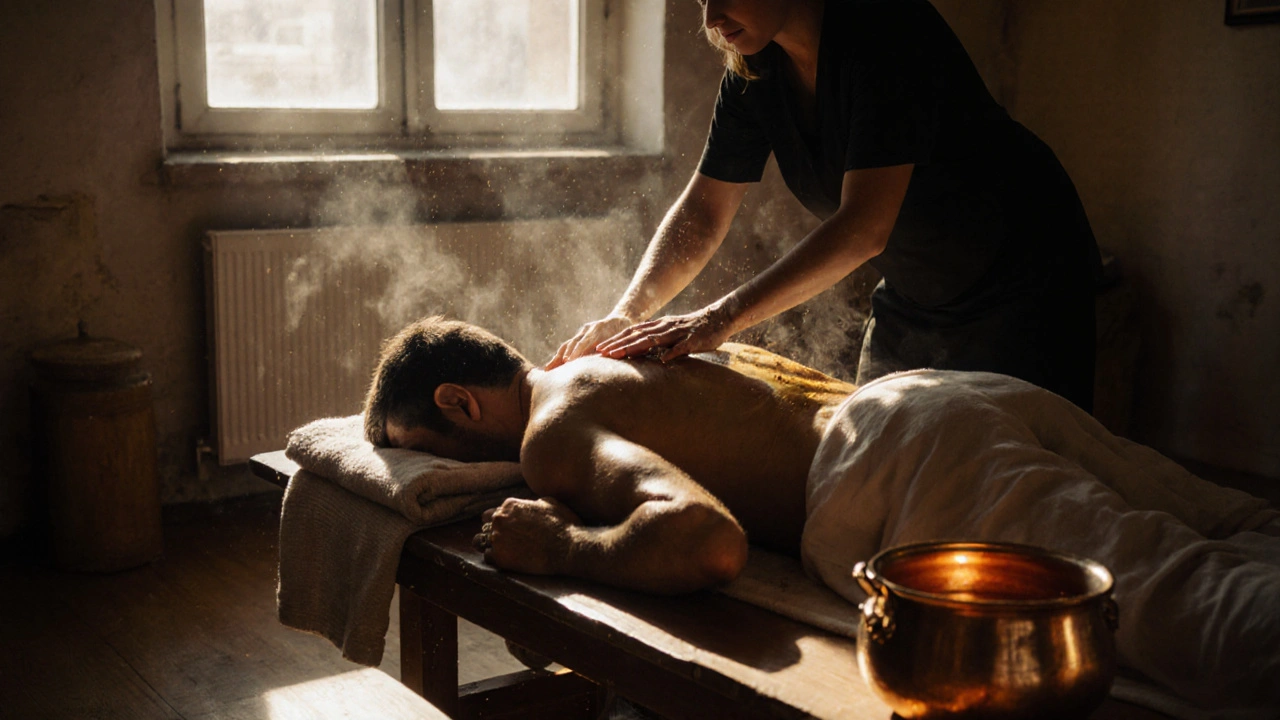
What to Expect During Your First Session
You won’t be asked to undress completely. For head massage, you stay fully clothed. For full-body, you wear loose cotton underwear. The room will smell like cumin, sandalwood, or dried neem leaves. No candles. No music. Just quiet.
The therapist will start by asking you about your sleep, digestion, stress levels, and even your emotions. They’ll touch your pulse - not to predict your future, but to assess your dosha. Then they’ll warm the oil between their hands. The massage begins with slow, circular motions on the scalp. You’ll feel warmth spreading. Your shoulders drop. Your breathing slows. That’s not placebo. That’s your nervous system shifting.
During full-body massage, expect deep pressure. It might feel uncomfortable at first. Some people even cry. That’s normal. The oil opens the channels. Emotions rise. Don’t fight it. Let it pass.
Afterward, you’ll be offered warm ginger tea. Don’t rush out. Sit quietly for 10 minutes. Your body is still processing. If you shower right away, you wash away the healing oils. Wait at least 2 hours.
Who Should Try It - and Who Should Avoid It
Indian massage isn’t for everyone. But it’s perfect for:
- People with chronic stress or anxiety
- Those with tight necks, headaches, or insomnia
- People with digestive issues like bloating or constipation
- Anyone who’s tried everything else and still feels drained
Avoid it if you:
- Have open wounds, infections, or recent surgery
- Are pregnant (unless you see a therapist trained in prenatal Ayurveda)
- Have severe osteoporosis or blood clotting disorders
- Just want a quick “me time” treat - this isn’t a pamper session
One thing people don’t tell you: Indian massage isn’t a one-time fix. It’s a practice. Like yoga or meditation. One session helps. Two helps more. Three? You’ll notice your sleep changes. Your skin glows. Your mind feels lighter.
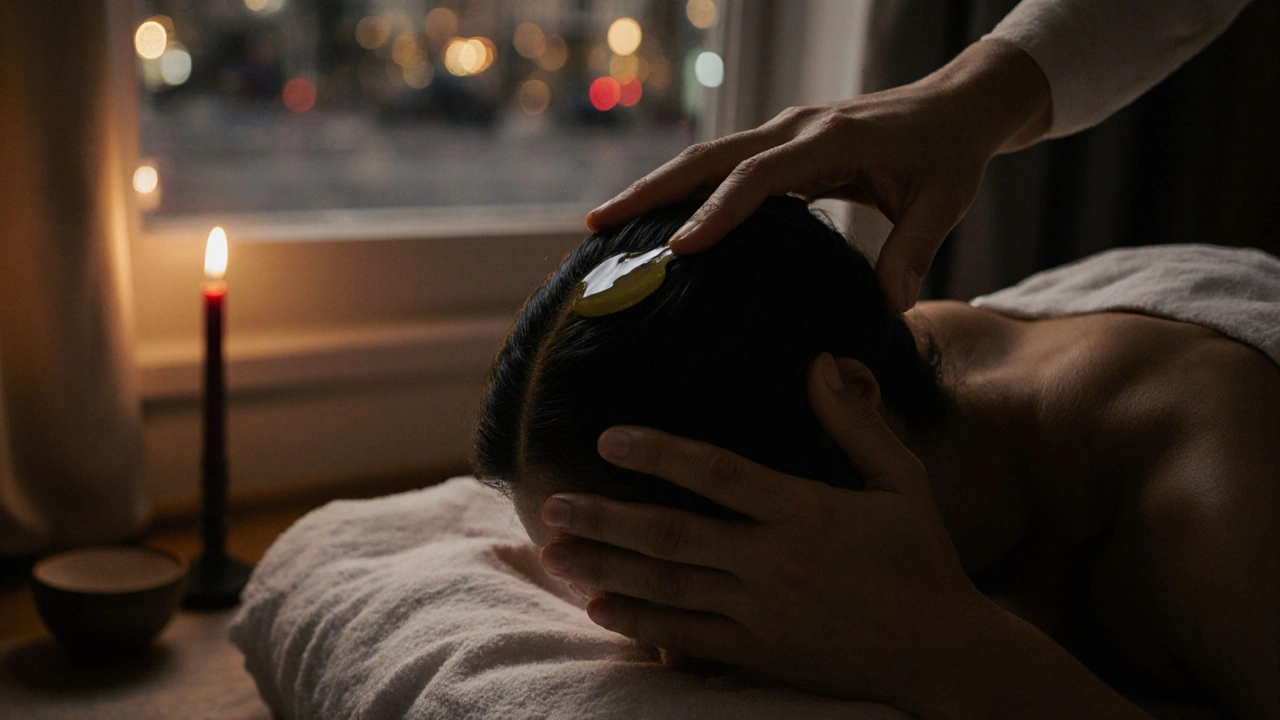
How Often Should You Go?
For general wellness, once a month is enough. If you’re dealing with stress, headaches, or burnout, aim for once a week for 4-6 weeks. After that, drop to biweekly, then monthly. Most regular clients in London stick to a 2-4 week cycle.
Some places offer monthly packages. Shanti Ayurveda has a £220 plan for 6 head massages. That’s £37 per session - cheaper than a weekly coffee habit. And it lasts longer.
DIY Indian Head Massage at Home
Can you do it yourself? Yes - and you should. Even 10 minutes a day helps.
- Warm 2 tablespoons of coconut or sesame oil. Don’t microwave it. Use a bowl of hot water.
- Part your hair down the middle.
- Use your fingertips (not nails) to make small circles on your scalp. Start at the forehead, move to the temples, then the back of the head.
- Massage your neck with slow, downward strokes.
- Leave the oil on for 30 minutes. Wash with a mild shampoo.
Do this before bed. You’ll sleep deeper. Your hair will grow stronger. And you’ll start to understand why this practice survived 5,000 years.
Why This Isn’t Just a Trend
Indian massage isn’t new. It’s not trendy. It’s been used by farmers, monks, and mothers in India for millennia. In London, it’s not a fad - it’s a quiet revolution. People are tired of quick fixes. They want something that lasts. Something that doesn’t just numb pain, but heals it.
If you’ve been searching for relief - for better sleep, less anxiety, deeper calm - this might be it. Not because it’s exotic. But because it’s real. And in a city that never stops moving, sometimes the slowest thing is the most powerful.
Is Indian massage the same as Ayurvedic massage?
Yes, mostly. Indian massage is a broad term that includes Ayurvedic massage as its most traditional form. Ayurvedic massage follows the principles of Ayurveda - using herbal oils, marma points, and dosha-based approaches. Other types like Indian head massage are also part of the Indian tradition but don’t always follow full Ayurvedic protocols. In London, most places offering "Indian massage" are actually doing Ayurvedic-style work.
Does Indian massage hurt?
It can feel intense, especially if you’re used to light Swedish massage. The pressure is deeper, and the strokes are more rhythmic. But it shouldn’t be painful. A good therapist will adjust pressure based on your feedback. If you’re wincing or tensing up, speak up. The goal is release, not punishment.
Can I get Indian massage if I’m not Indian?
Absolutely. Indian massage isn’t cultural exclusivity - it’s ancient science. Thousands of non-Indian people in London use it regularly. The techniques work regardless of ethnicity. What matters is your body’s response, not your background.
How long does an Indian massage session last?
Head massages usually take 45 to 60 minutes. Full-body Ayurvedic sessions last 75 to 90 minutes. Some places offer shorter options, but those are often watered-down versions. For real results, go for the full time.
Do I need to book in advance?
Yes - especially at authentic places. Many therapists have waiting lists because they limit clients to maintain quality. Don’t expect walk-ins. Book at least a week ahead, or you’ll end up at a tourist trap.
Is Indian massage expensive in London?
It’s priced like skilled therapy - not luxury. A head massage starts at £45. Full-body Ayurvedic sessions range from £70 to £110. Compare that to a £90 deep tissue massage that leaves you sore. Indian massage leaves you calm. You’re paying for expertise, not ambiance.
Can Indian massage help with hair loss?
Yes - especially the head massage. The pressure improves blood flow to the scalp. The herbal oils nourish follicles. Many people report less shedding and thicker hair after 6-8 weekly sessions. It won’t regrow hair lost to genetics, but it can slow down stress-related thinning.

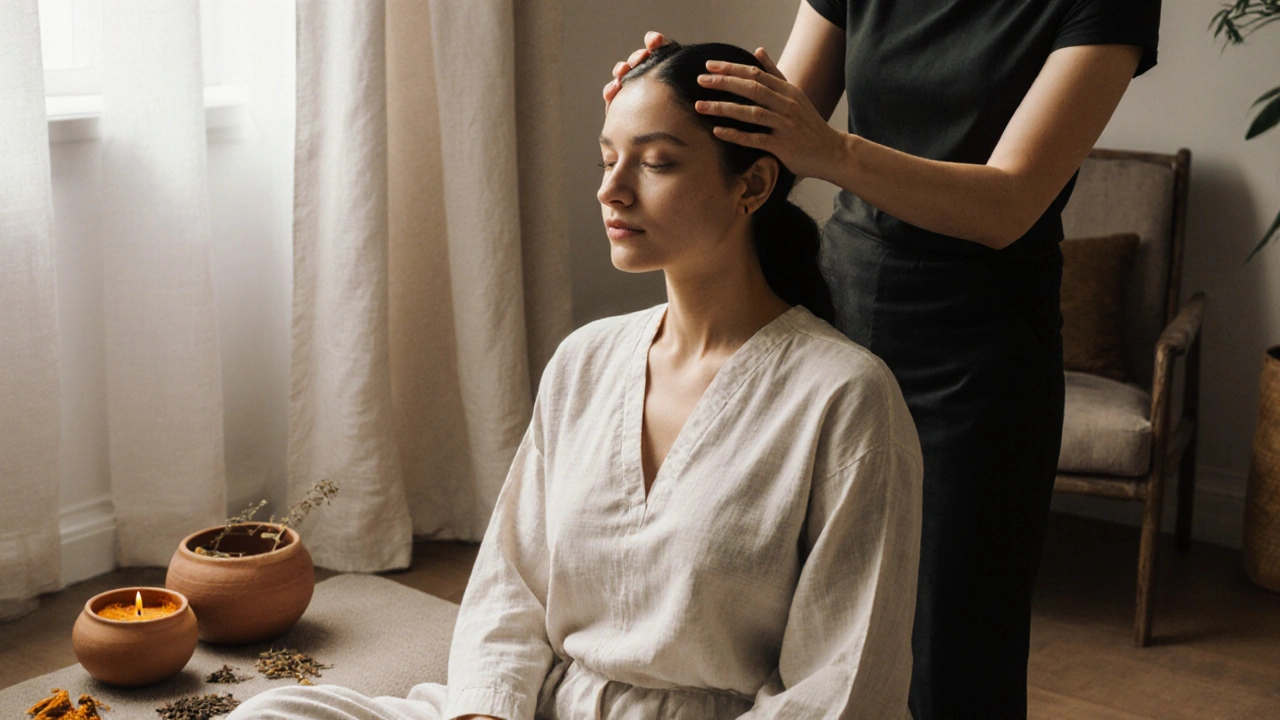
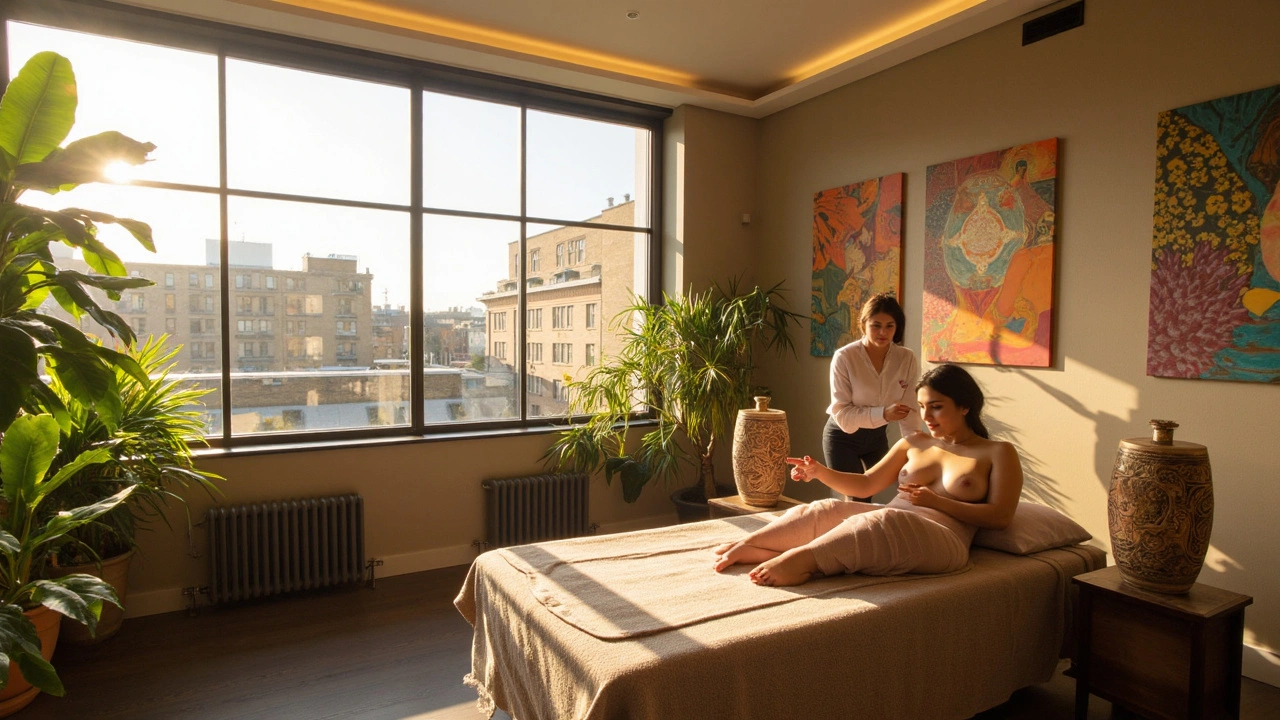

Kayla Hochard
November 22, 2025 AT 21:32This is the most ridiculous thing I've read all week. You're telling me some guy in Camden rubbing sesame oil on my scalp is gonna fix my stress? I've got a PhD in neuroscience and I've never seen a single peer-reviewed study that proves 'marma points' exist. This is just ancient superstition dressed up as wellness porn. If you want real relaxation, go get a chiropractor or a damn massage gun. Stop romanticizing colonial-era myths as 'medicine'.
And don't even get me started on the 'dosha' nonsense. You're not a Hindu monk. You're a 30-year-old finance worker in London. Stop pretending you're spiritually enlightened because you used coconut oil.
Also, £110 for a massage? That's a robbery. I can get a full-body deep tissue at my gym for £40. At least there, they know anatomy.
And who the hell writes 'the room smells like cumin and neem leaves' like it's a spa review? That sounds like a kitchen after a curry explosion. Gross.